Li Shan, 1974-1978, Untitled
A lot of attention is focused on trees these days. Not only do they take carbon out of our atmosphere and store it, as we all were taught in school, and give us shade, helping to cool the planet, but more recently we've learned that a forest works as a community, protecting each other, operating as one huge organism. Through mycorrhizal, or fungal networks, they share scarce nutrients, warn of dangers, communicate stress, tell their neighbors to build up their immune systems, or prepare for a harmful insect. The older veteran trees, sometimes called mother trees, nurture the seedlings and somehow impart their knowledge. We could learn a lot from the way they care for each other.
Click here if you'd like to listen to Respighi No 3 Notturno for Harp, played by Magdalena Hoffman, while you look at the post.
Above: Bae Bien U at the V & A, London. Bae Bien U's trees look to me like mysterious dancers in the dusk, communicating silently as trees do.
Above: Anya Gallaccio, Installation view, Tate Britain, London
Above: Lois Dodd, Sky Through Trees. More of Lois Dodd's work can be seen here.
Photo: Laura Clayton Baker
Above: From our visit to Kanazawa in 2019, at the Kenrokuen Garden.
Above: Lois Dodd, High Sun in Trees, 2015, Oil on aluminum flashing
Above: Ira Vasilieva, Russian painter.
Above: Fairfield Porter Winter Landscape (Snow), 1958-61
Above: Li Shan, Bear's Footprints, 1974-1978
Above: David Hockney from the book Hand Eye Heart, Watercolors of the East Yorkshire Landscape
Above: Alex Katz, Winter Branch, 1993
Above: Barbara Levittoux-Swiderska, Detail. Polish artist. Seen here.
Photo: Kate Comings
Above: I include this photo because it reminds me of the most wonderful place memory I have....a pine forest next to the Quabbin Reservoir in Massachusetts, where in the winter each pine needle was covered in ice. The trees were large enough to be able to stand under their branches, and to be under the canopy was like being inside a cathedral with the ice needles glistening and chiming.
Above: Piet Mondrian, Study of Trees, 1912
Above: Piet Mondrian, Tree II, 1912
Above: Tacita Dean, Majesty, 2006. Majesty is one of the oldest oak trees in England. This photo was massively enlarged and printed on 4 overlapping sections of fiber based paper. All the area surrounding the trees leafless branches and trunk have been overpainted in white gouache, isolating the structure of the tree.
Above: Eugene Atget (1857-1927), Pollarded Trees
Photo: Ariel Kozak
Above: Found here.
Photo: Laura Clayton Baker
Above: Tree seen on Naoshima, 2015
Photo: Minh T.
Photo: Bernard Gagnon
Above: Grandidier's Baobab, near Morondava, Madagascar, the biggest and most famous of Madagascar's six species of Baobabs.
Above and below: Neil Burnell's photos of Wistman's Wood in Dartmoor, England. These photos were taken just before sunrise. They hold the mystery of a fairytale.
Above: Yellow Tabebuia Trumpet tree found here blooming in Sao Paulo, in September, their spring time.
Photo: Laura Clayton Baker
Above: Laburnum blossoming in London.
Above: Lucien Frank, from his show at "In The Canyon". This is from a series of paintings done in our neighborhood in Santa Monica, and he's captured the character of many places I see daily.
Photo: Laura Clayton Baker
Above: Another view in our neighborhood...a sycamore resting on a eucalyptus.
Above: Li Shan, Golden Pond, 1974-1978. Looking at Li Shan's work one wouldn't think she was a revolutionary but in fact her chosen subject matter was a dangerous choice at the time. She was a member of the "Wuming (no name) Painting Collective", an underground counter culture group formed in 1969. At a time during the Cultural Revolution (1966-1976), when Chinese art turned into pure political propaganda, and art for its own sake was forbidden, the Wuming staged their own rebellion by painting non-political subjects on small sheets of paper and cardboard, shown only to close friends. A 1971 painting by Li Shan of two discarded soda bottles in a field is considered one of the first post modern Chinese artworks. A documentary about the group can be seen here.
Above: Fairfield Porter (1907-1975), Trees in Bloom, 1968
Above: Alex Katz, Apple Blossoms, 1994
Photo: Laura Clayton Baker
Above: Spring blossoming tree, NYC
Above: Li Shan, Peacock and Crane, 1974-1978
Above: Blossoming peach tree, found here.
Above: Whitney Bedford, Veduta (Vuillard Purple Trees), 2021
Above: Whitney Bedford, Veduta, (Bonnard Mediterranean), Triptych, 2021
Photo: Ryu Haharu
Above: Cherry blossoms in Japan found here.
Above: Adrian Stokes (1902-1972), Olive Terraces, 1938 and 1952
Above: Ori Gersht, Olive 6, from the series "Ghost", 2003
Above: Beth Moon, Nardo, from her series "Titans", a group of ancient olive trees from the southern tip of Puglia. Beth Moon has traveled the world documenting the oldest trees. Her work is remarkable. The story of time and climate is told in the twisted gnarled trunks that have managed to survive thousands of years.
Above: Another Beth Moon photo, this is The Much Marcle Yew, from the series "Portraits of Time".
Above: Children of the Pre-Raphaelite painter Edward Burne-Jones and Arts and Crafts artist William Morris in a tree...from left to right Margaret Burne-Jones, May Morris, Jenny Morris, and Phillip Burne-Jones. May Morris was a talented artist herself, designing patterns for Morris and Co that were looser than the more regular patterns of her father.
Above: One of May Morris's designs, from 1883, Honeysuckle. May Morris is the 2nd from left in the photo above.
Above: From Alicia Bay Laurel's book "Living on the Earth", a 1970s guide to living close to nature and making everything yourself. Her drawing style influenced all my teenage doodling and continues to exert its pull subconsciously.
Above: An illustrated map of 100 Acre Wood, the home to Pooh and Piglet, Christopher Robin, Owl, Eeyore, Kanga and the rest. Many of the stories have trees as an important feature, and when I see a large sheltering oak tree I always think of these stories.
Above: Christopher Robin's home
Above: Owl's tree
Above: The Keebler elves seem to have an abode not unlike Christopher Robin's.
Above: Tweety bird has a more traditional home in a tree.
Above: The most iconic tree house has to be the one portrayed in the Swiss Family Robinson. This is the original sketch for the actual tree house.
Above: The Swiss Family Robinson tree house was actually built in a Saman Tree on the Caribbean island of Tobago. The 200 foot tall tree had low branches perfect for creating the structure they'd planned. The strong limbs of the tree could hold as many as 20 crew members during filming.
Above: Bart Simpson's tree house
Above: Photo by Cydney Puro, Le Marche, Italy, found here.
Above: The Nordic Pavilion for the Venice Biennale, 1958-1962, designed by architect Sverre Fehn. The structure is built around four trees.
Above: Unknown location.
Above: Photo by Gordon Reynolds, Sculpted Trees, Half Moon Bay
Above: Susanna Howe, Bridge, 2017, Sears Peyton Gallery
Above: Found here.
Photo: Laura Clayton Baker
Above: This grand weeping willow tree is a surprise to be found in a parking lot on the lower east side, in NYC, looking much too glorious for its utilitarian setting.
Photo: John Derian
Above: John Derian has taken a series of photos of this lovely tree in Albert's community garden just a few steps from his store on 2nd Street, and he posts them on instagram. I love seeing how this tree changes with the seasons. I added one I took myself in October, before the leaves changed color.
Photo: Laura Clayton Baker
Photo: John Derian
Photo: John Derian
Above: Ken Kiff, part 1 of Triptych: Shadows, 1983-1986
Above: Andrew Cranston, Pitch Blue, 2021, oil on hardback book cover
Above: Mitch Epstein, Eastern Cottonwood, Sprague Avenue, Staten Island II, 2011. In Mitch Epstein's book "New York Arbor", he photographs some of the stateliest trees in NY. To take a picture of such a large tree he climbs a tall ladder to get the right angle. An interview with Epstein when his trees were included in a Voyages issue in the NY Times here.
Above: Mitch Epstein, American Elm, Central Park, New York, 2012.
Above: Mitch Epstein, English Elm, Washington Square Park, New York, 2012.
Above: Beauford Delaney (1901-1979), Washington Square, 1949
Above and below: Evelyn Dunbar (1906-1960), Winter Garden, 1929-1937, detail below
Photo: Bill Jacobson
Above: Joseph Beuys, part of a project called 7000 Oaks. Walking down 22nd Street in Chelsea, I've always wondered about the granite stone markers. It turns out they're part of a project Joseph Beuys started in 1982, in Kassel, Germany, called 7000 Oaks, subtitled "City Forestation instead of City Administration". Between 1982 and 1987, with the help of volunteers, Beuys had planted 7,000 trees in Kassel. A stone was placed next to each tree to provide it nourishment as it eroded. In 1988 the Dia Foundation continued the project by planting five trees (a gingko, a linden, a Bradford pear, a sycamore, and an oak) along 22nd Street between 10th and 11th Avenues and in 1996 they planted 25 more trees, each with its own basalt stone. Beuys died in 1986, before the 7,000th tree was planted, but his inspiration lives on. He intended the project to be the first stage in an "ongoing scheme of tree planting that would extend throughout the world as part of a global mission to spark environmental and social change".
Above and below: When the residents of Warfield Place in Northhampton, Massachusetts learned that their beautiful Japanese Kwanzan cherry trees were slated for demolition they came together to try and save them. Local resident and well known author Ruth Ozeki, a Zen Buddhist priest, participated in a traditional ceremony with 5 other Buddhist priests to ordain the trees as Zen priests themselves. In a letter to the city they say "In our Zen Buddhist tradition, we understand trees, mountains, rivers, and the whole of sentient life, to be sacred teachers of spiritual wisdom". Sadly, despite this, and a petition from 2,100 residents the trees were taken down. But in Thailand, where the practice of ordaining trees originated, and now in Cambodia, both countries where 90% of the population practices Buddhism, the "ecology monks" have more influence, and their ordination of trees and fighting in other ways for the environment, is having greater impact.
Photo: Kevin Gutting for the Daily Hampshire Gazette
Above and below: Ordaining the cherry trees. Ruth Ozeki at right above. The terra cotta wrap represents the garb of a monk.
Photo: Kevin Gutting for the Daily Hampshire Gazette
Below: The Shinto religion developed in Japan over 3,000 years ago. It has no theology and is founded in nature based animism and the veneration of ancestor spirits. Shinto equates to the belief or faith in kami. Some kami are creator deities, some are nature deities, some are ancestors who have been deified. Nature kami may reside in trees, rocks, caves, volcanoes, mountains, waterfalls, and streams, or may exist in natural phenomena like rain, fire, and earthquakes and wind, or they may take the form of spirit animals. A shinto priest may invite kami to descend into a shrine, and people have alters in their homes for kami as well. Kami are not purely good...they can love and nurture when respected, and cause destruction and disharmony when neglected. They must be appeased to gain their favor and avoid their wrath.
Photo: Julianne Skai Arbor AKA Treegirl
Above: In the Shinto religion trees are seen as antennas to the spiritual world. This photo shows a fenced off area called a himorogi where the tree is surrounded by paper fortunes. Prayers are also tied directly onto tree branches as transporters to a divine realm.
Photo: Julianne Skai Arbor AKA Treegirl
Above: A rope bearing folded paper shide, strung around the trunk of a tree as well as other sacred objects is called a shimenawa. Sometimes these ropes are used to identify shrines.
Above: Some ancient trees believed to have kami living in them are considered to be shrines. This one, the Takeo Camphor, has such a cavernous space that visitors can enter the space at the bottom of the tree and leave offerings. These divine trees are called shinboku.
Photo: Sarah Caron
Above and below: A province in Pakistan pledged to plan 1 billion trees in 2015. It was such a success that the country is now endeavoring to plant 10 billion trees to fight climate change. It's dubbed the "Ten Billion Tree Tsunami". This is a view of slopes planted a few years ago.
Photo: Sarah Caron
Above: To develop seedlings for the massive planting project tree nurseries are developed with local communities.
Photo: Sarah Caron
Above: Students and volunteers plant saplings in Islamabad.
Photo: Sarah Caron
Above: A local employee of the forestry department planting near his village.
Above: James Dickson Innes (1887-1914), Arenig, North Wales, 1913.
Above: Sally Michel (1902-2003), Trees in Field. Sally Michel Avery was the wife of artist Milton Avery. The images here are from a 2015 show at D. Wigmore Fine Art.
Above: Sally Michel (1902-2003), Spring Forest, 1956.

Above: Jacques Trumphemus (1922-2017)
Above: Pierre Bonnard (1867-1947), Palme Tree at Le Cannet, 1924
Above: Paul Klee, Park Near Lucerne, 1938
Above: Sally Michel (1902-2003), Autumn, 1956
Above: Hayley Barker, Dream Front Yard with Visitor, Black Pit Bull, 2021.
Above: Alex Katz, Apple Trees, 1954
Photo: Laura Clayton Baker
Above: Apple orchard in Shelburne, Massachusetts. They have all sorts...Macouns, Honeycrisps, Macintosh, Cortlands and more.
Photo: Laura Clayton Baker
Above and below: A cherry orchard in Michigan near Traverse City.
Photo: Laura Clayton Baker
Above: Maira Kalman, Alice B. Toklas Crying under a Tree, Toledo, Spain. She's included this drawing in her piece for the New Yorker, "Looking at a Tree".
Above and below: Leanne Shapton, from her book "The Native Trees of Canada".
Photo: Laura Clayton Baker
Above: Unusually shaped leaves of the Mulberry tree.
Photo: Laura Clayton Baker
Above: Chestnut tree leaves
Above: Bark detail
Above: Pieter Bruegel the Elder (1525-1569), The Harvesters, 1565, Detail. Trees have a way of drawing everyone together...a focal point, a place to lean, and to find shade. This painting, part of a series of six, was groundbreaking in its focus on humanism, with no religious theme.
Above: Bob Thompson (1937-1966), Harvest Rest. This is his version of the previous painting by Breugel.
Above: Bob Thompson (1937-1966), Judgement of Paris. 1963. Another gathering under a tree. Thompson was interested in synthesizing Baroque and Renaissance masterpieces with the jazz influenced abstract expressionist movement. In the late 1950s he spent time in NY with a circle of artists and jazz musicians at places like the Five Spot. In 1961 he received a Whitney Foundation fellowship, enabling him to move with his wife to Europe where he had a chance to spend time looking at the old masters. In the early to mid 60s he had solo shows in NY and Detroit. He died in 1966 shortly before his 29th birthday, but accomplished a great deal in the years he had. In 1998 The Whitney Museum mounted a retrospective of his work.
Above: Bob Thomson, Adam and Eve, 1964
Above: Paul Serusier (1864-1927), Young Breton with a Pot of Vermillion and a Kneeling Little Girl, 1892.
Above: Paul Serusier (1864-1927), Incantation of the Sacred Forest, 1891-1892
Above: Emily Carr (1871-1945), Forest Glade, 1938-1940. Found here.
Above: Syo Tatsu, Painting of a tree's roots hung on a tree.
Above: George Garrard (1760-1826), Coombe Hill, 1791.
Above: Li Shan, 1977
Above: Vincent Van Gogh (1853-1890), Pen and ink drawing.
Above and below: Hasegawa Tohaku, Pine Trees, details from washi paper screens, 16th century.
Above: William Henry Fox Talbot (1800-1877), an oak tree in winter, 1842-1843. Calotype negative and salted paper print. Talbot was a scientist, inventor, and photographic pioneer who invented the calotype and salted paper process, a precursor to photogravure printing.
Above: Tacita Dean, Crowhurst, 2006. This yew tree is located on the grounds of a 12th century church, and is said to be over 4,000 years old.
NOTE: Should you like a forest to listen to here's a site with a selection.....tree.fm
Above: Beth Moon's photograph, The Queen Elizabeth Oak, from her series "Portraits in Time".
Above: Beth Moon's photograph, Majesty, from her series "Portraits in Time". You can see Tacita Dean's portrait of the same tree near the start of this post, during winter. This is the largest non-pollarded oak in Britain, perhaps in Europe.
Photo: Ariel Kozak
Above: Found here.
Photo: Ariel Kozak
Above: Found here.
Photo: Laura Clayton Baker
Above: Ancient tree limbs supported with stilts, Kenrokuen Garden, Kanazawa.
Above: Beth Moon's photo, Kapok.
Above: Beth Moon's photo, The Whittinghame Yew.
Above: I remember being in awe driving through this tree when I was a kid...Seems to still be alive and possible to drive (or walk) through. The Chandelier Tree is in Leggett California, privately owned, and you can get all the info here. There's an article about the redwoods, with a story of the family that owns the tree here.
Above: Middle Schoolers linked around a redwood in Jedidiah Smith Redwoods State Park, near Crescent City, California.
Photo: Janet Friesen
Above: A tree carving in the Tongass Rainforest, Ketchikan, Alaska.
Above: Twisted tree, found here.
Above: Anne W. Brigman (1869-1950), The Dying Cedar. A spiritual connection with nature was the theme of Brigman's art and life. Her figures are shown as extensions of their natural surroundings.
Above: Beth Moon, Bristle Cone Pine Relic.
Above and below: Raoul Hague (1904-1993), wood sculptures. Hague seems to be bringing something essential out of the wood, rather than making the wood conform to an idea he might project onto it. Born in Constantinople, he spent most of his life living and working in Woodstock NY.
Photo: Lee Friedlander
Photo: Lee Friedlander
Above: Photos from a book by Lee Friedlander: "Raoul Hague, His Work and Place, A Memoir".
Above: Raoul Hague
Above: Thaddeus Mosley (born 1926), Masked Extension, 2011, 48' x 52" x 26", walnut and cherry. Mosley is a Pittsburgh based self taught artist whose monumental sculptures are carved with felled trees from the city thanks to the Forestry Division, wood from local sawmills, and reclaimed building materials. Using only a mallet and chisel he reworks salvaged timber into biomorphic forms. Influenced by Brancusi and Noguchi as well as Bamum, Dogon, Baoule, Senufo, Dan, and Mossi, works in his personal collection, he calls these "sculptural improvisations", taking cues from the modernist traditions of jazz. These photos and bio are from his 2020 show at Karma in NY.
Above: Thaddeus Mosley, Countee's Leaf, for Countee Cullen, 1992, carved walnut and cherry.
Above: Thaddeus Mosley's studio, Pittsburgh
Above: Thaddeus Mosley installation at Karma, 2020.
Photo: Laura Clayton Baker
Above and below: Arborica, in Petaluma, is the place to find the most amazing wood...trees they've salvaged that have been felled by storms or old age or disease. One can imagine the work that can come from pieces like these.
Photo: Laura Clayton Baker
Above: Sculpture by J.B. Blunk (1926-2002), #2 Arch, 1976, Redwood. The photo is from a beautiful monograph on Blunk edited by his daughter Mariah Nielsen. Blunk's approach to life touched every element of his world, from the doors of his house, indeed the whole structure of the house, to furnishings he made inside it...the kitchen table, beds, chairs, hooks, handles, hardware, cups, to jewelry for his wife Christine, and of course the sculptures he carved from huge stumps of cypress and redwood. You can see the influence of his time in Japan with Isamu Noguchi, apprenticing with Rosanjin Kitaoji and Living National Treasure Kaneshige Toyo, in combination with the appreciation he had for the huge trees of the wild California landscape. Pictures of the house interior in this T magazine slide show.
Above: J.B. Blunk, Untitled, 1965, Cypress
Photo: Laura Clayton Baker
Above: J.B. Blunk, from a show in 2010 at Blum and Poe.
Above: The entrance to JB Blunk's home in Inverness, with one of his sculptures creating the entryway.
Above: Paul Klee (1879-1940), The Harbinger of Autumn, 1922, found here.
Above: Paul Nash (British, 1889-1946), Autumn Landscape, 1923, via @folesdog
Above: Hayley Barker, Brooklyn Backyard December, 2021
Above: Mies van der Rohe's Farnsworth House, photo found here.
Photo: Laura Clayton Baker
Above: Fall color at the D. T. Suzuki Museum in Kanazawa.
Above: A 1,400 year old ginkgo tree at the Gu Guanyin Buddhist Temple in China, dropping its leaves. Ginkgo trees are considered living fossils, having remained unchanged for 270 million years. They're even older than dinosaurs. Found here.
Above: An example of crown shyness where trees seem to deliberately make an effort not to overlap and to give each other breathing space, access to the sun. Found here.
Above: Tom Thomson (1877-1917), Autumn, Algonquin Park, 1916-1917.
Above: Lois Dodd, The Field, Cushing, 2020
Above: Li Shan, 1974-1978, untitled
Below: My husband Steven's sketchbook pages from various autumns.




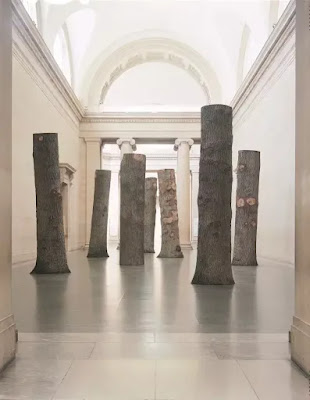

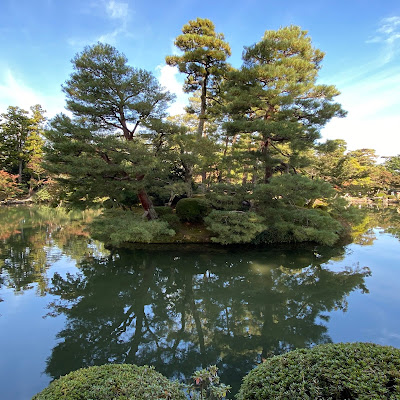
























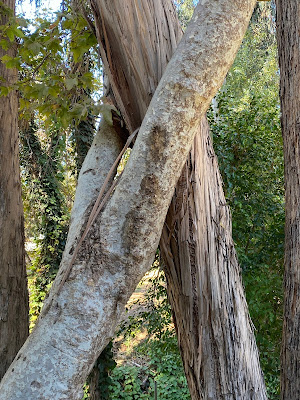



















































































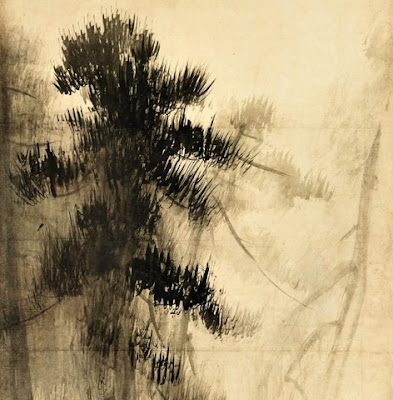


























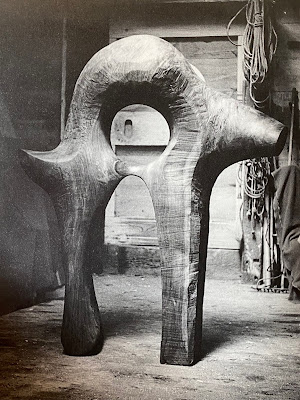

















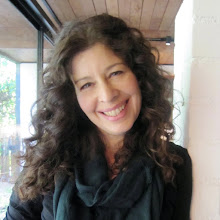



What an incredible tree journey! Your posts are divine gifts. Thank you! And thanks for including Suzanna Howe! XO
ReplyDeleteSo appreciate your kind words!
DeleteLaura,now that wind has stripped our trees,it is especially lovely to gaze at these. I also want you to know that Alicia Bay Laural is 50 year friend of mine. She will be pleased to know she inspired you. Our older children used Living on the Earth as a coloring book, because Alicia left some behind after her winter living here. Shall I send her this link?
ReplyDeleteOh please do! What a lovely image to have, your kids coloring in her book. Thank you!
ReplyDeleteThank you, Laura. Beautiful! I wasn't aware of Hayley Barker or Sally Michel. Really enjoy their work. Hope you're good.
ReplyDeleteThanks so much for sending me this,Laura.A wonderful collection of trees. I look forward to looking at your other posts. Roz
ReplyDeleteThank you Laura for showing me the many ways that artists see trees. I love the humor of some images. Trees can drape themselves over the top of a house, pose for trick photos that reminded me of the Leaning Tower of Pisa, lean on each other like old friends. Your posts always change my way of looking at the world.
ReplyDeleteLove your comment...not sure who wrote this, but thank you!
DeleteThis comment has been removed by the author.
ReplyDeleteSo lovely, as ever. I particularly appreciated the inclusion of JB Blunk's work and home among the Inverness trees! xo
ReplyDeleteI save your blog to read in a moment of quiet and savor. I love all the images you included -- Tweety Bird, included. Thank you for this.
ReplyDeleteThis was the most delightful read!!! Thank you! I've just come home from the Caribbean lush greenery to Connecticut and sleeping trees. This put a big smile on my face.💚
ReplyDeleteWonderful post, thank you!
ReplyDeletewonderful, ponderous; Always love the intimacy of your artist choices...exceptionally good
ReplyDelete